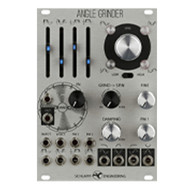Schlappi Engineering - Angle Grinder
by Tim Held
The Schlappi Engineering Angle Grinder is a 100% analog quadrature sine wave oscillator with a waveshaper section that is wonderfully designed, both externally and internally. Its LED game is, as the kids say, on fleek, the panel layout allows for access to all controls when fully patched, and it’s wonderfully tweakable in live situations due to the large sized metal knobs and smooth as silk sliders.
The Angle Grinder is comprised of two sections: Spin and Grind. The Spin section consists of four outputs ranging from 0 to 90 to 180 to 270 degrees when oscillating. This offers four sine waves or, if in lower ranges, four LFOs. The Grind section is where the real fun is. Its output sends a sine wave similar to that of the Spin section, but Grind's output can really be brought to life when utilizing its waveshaping sliders. The input of the Grind section can receive audio or CV, so you could pass another VCO or other modulation source through Grind in order interact with the waveshaping sliders as well.
What’s really neat about these two sections is that you can feed the Grind section into the Spin section and the waveshaper will become a voltage controllable non-linear feedback network–turning the four oscillator outputs into mangled filters with their own unique frequency responses. You can also use the four sine wave outputs and send them to different VCAs with their own distinct envelopes being fed into them, which, when paired with delay and/or reverb, can make for quite an elaborate swath of sounds. On top of this cloudy blanket add the Grind output with your favorite CV sources controlling the waveshaper inputs, and marvel at a fully fleshed out, one-voice patch.
When it comes to bass, the Angle Grinder delivers. No matter what frequency range I want my lows to occupy, I can find it here. Whats more, if I want to use a bassline as both an anchor point [low, soft sine wave] and a focal point [brash, wiggly, squacky] I know it’s achievable through the use of the Grind out and one of the four sine wave outputs. When using this approach I typically run one of the sine wave outputs directly into a mixer while passing the Grind output through a VCA controlled by a basic envelope, and I utilize the waveshaping and Grind inputs to give the mid and high frequencies of the bassline more character. The Spin section’s sine output creates a smooth, almost inaudible foundation for the extremely active and dynamic Grind bassline with which to dance upon. Sometimes I don’t use the sine and Grind output at the same time, but rather fade one out as the other comes in, to emphasize feel.
Even though the Angle Grinder excels at bass, it’s certainly not limited to the low end of your patch. You can make leads with this thing! Slap some CV into those wave shapers and feed a super fast Maths channel 4 into the Grind input and whisk yourself back to the time of baggy orange pants and pacifier necklaces. I find that I prefer to manually control the waveshaping sliders when playing leads rather than using a lot of modulation sources to do so, as this gives the lead line a little more unpredictability and adds some human feel.
The Angle Grinder can also be utilized as an LFO. Having its four sine waves out of phase with each other allows it to be used in interesting ways and for multiple jobs. Once again the Grind section steals the show. Use the Grind output as the LFO and then feed another LFO, slope, or envelope into one or more of the waveshaping inputs to create a highly complex modulation source. I personally like using it to modulate the PWM of an oscillator, and then speeding the LFO up to audio range to land on a note that compliments the voice that’s being modulated!
Using the Angle Grinder as a variable state filter, the option to blend the outputs of the oscillator and the signal being sent into the Grind input for filtering makes it really interesting. When using the Grind section, the Grind/Spin knob filters the signal fed into its input if turned completely clockwise, and as it is turned counter-clockwise toward oscillate, the Grind oscillator output is blended in. You can push this section further if the Grind section’s input knob is played with. While all of this is happening, patch one of the sign wave outputs to your mixer for a more rounded out version of what is being fed into the Grind input. To give it extra character, turn the Damping knob from Filter to Oscillate.
The Angle Grinder is a really unique and versatile module, and as complicated as everything I have mentioned might sound, it’s a pretty easy module to get the hang of. I don’t think I’ve gotten all that the Angle Grinder has to offer, so I’m looking forward to a long and fruitful relationship with it.
18HP +12v: 81mA -12v: 78mA
Price: $310


